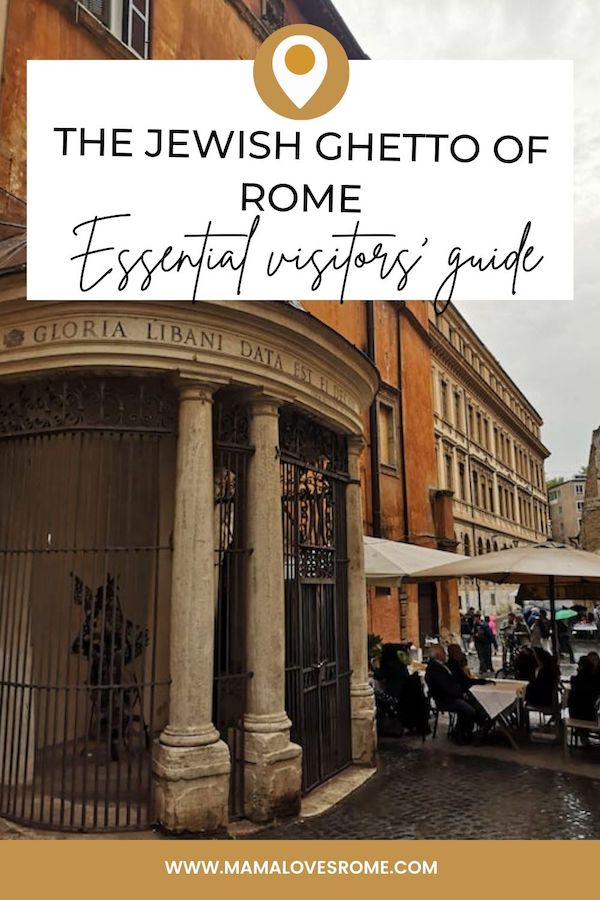The Jewish Ghetto of Rome: visitors’ guide with the best things to see, best Rome jewish ghetto restaurants, main historical facts.
Rome’s Jewish Ghetto is a beautiful, fascinating and historically significant neighborhood in Rome city center.
Located between the River Tiber and Largo di Torre Argentina, in the Rione Sant’Angelo neighborhood, the Jewish Ghetto of Rome is one of the most ancient in Italy, the second most ancient after that of Venice.
Here, you find the Rome Synagogue, ancient Roman ruins, pretty cobbled streets, tons of restaurants and many memories of one of the darkest times in the history of Rome: the fasci-nazi period.
I highly recommend you plan at least an afternoon to visit this area.
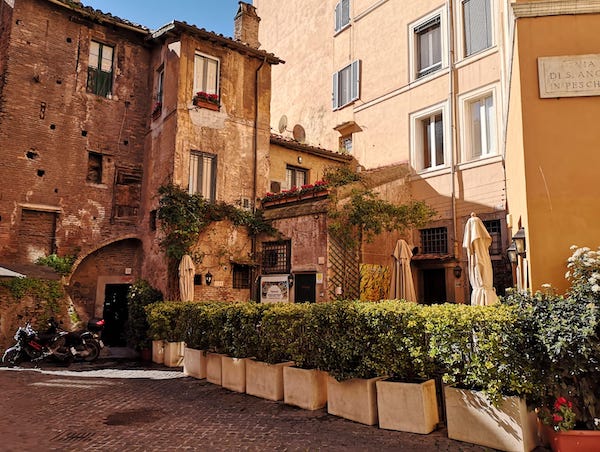
The atmosphere, the significance and the sheer beauty of the places is pretty much guaranteed to conquer your heart!
In this quick guide, I share the best things to see in the Jewish Ghetto of Rome, essential historical facts to put this area in context, restaurant recommendations and tips for visiting
Please note: this post contains affiliate links. Should you make a purchase through them, we might make a small commission at no extra cost to you.
The Jewish Ghetto of Rome map: location + how to get there
The Jewish Ghetto is in Rome city center, in the historical Rione Sant’Angelo.
It has the River Tiber on one side and its boundaries are argo Arenula, Via Florida, Via delle Botteghe Oscure, Via dell’Aracoeli, Via Margana, Piazza Margana, Via dei Delfini, Via dei Cavalletti, Via della Tribuna di Campitelli, Via del Teatro di Marcello, Via del Foro Olitorio, Lungotevere de’ Cenci, Via del Progresso, Piazza delle Cinque Scole, Via Santa Maria del Pianto, Via in Publicolis, Via di Sant’Elena.
The coat of arms of the neighborhood is either an angel holding a palm branch or a fish.
The Angel recalls the name of the neighborhood (San’tAngelo) while the version with the fish relates to the presence of an ancient fish market (Foro Piscario).
The Jewish Ghetto is a maze of pretty, cobbled streets, mostly car free and the best way to visit is on foot.
Buses serving this area include: 30, 40, 46, 492, 62, 64, 70, 87.
A very quick history of Rome Ghetto
The area we now know as Rome Ghetto has been inhabited since Roman times.
This area originally hosted temples of Roman Gods and Goddesses such as Apollo and Bellona and then developed to host a circus, a theater and a market.
In medieval times, the area acquired streets, shops and churches. In 1555, a significant event happened.
On the 14th of July 1555, Pope Paul IV Carafa issued the Papal Bill Cum Nimis Absurdum and declared ‘absurd’ how the Jewish people of Rome lived mixing with Christians.
He therefore created a Jewish Ghetto, a gated area where all the jewish of Rome would have to move and live. He settled in along the Tiber, close to the Tiber Island.
This is the area we know know as the Jewish Ghetto of Rome. The ghetto remained operational until 1870.
In the following decades, the whole area was demolished and rebuilt over the river level.
The XX century was an eventful time for Rome’s Jewish Ghetto.
In 1905 the area acquired the Temple but anti-jewish feelings and laws quickly grew, leading to the promulgation of the infamous Racial Laws of 1939.
In 1943, with the nazi-fascist occupation opened a new tragic chapter. On the 16 ottobre 1943, at night, the authorities raided the Jewish Ghetto of Rome and deported 1022 people. Very few returned.
With the liberation, the end of the war and then the republic, things started normalizing.
In 1987 the Rome community took the name of Community’ Ebraica di Rome and new agreements got reached with the Italian State.
Nowadays, the ghetto is a bustling, sought after area attracting locals and visitors with its delicious restaurants and unique atmosphere.
It is however also a fundamental place in Rome for remembrance and a touching, significant one dotted with memories of the prosecutions that happened in old and recent times.
Sources: Communita’ Ebraica di Rome ; Museo Ebraico di Roma
Best things to see in the Jewish Ghetto
The best way to explore the Jewish Ghetto of Rome is to walk around and take in the atmopshere. However, a few things are worth seeking out.
The Rome Synagogue and the Jewish Museum of Rome
The Synagogue of Rome towers about the area of the Ghetto and has a distinctive, easy to recognize dome you can see from all main viewpoints over Rome.
The Synagogues is the main Temple in Rome (Tempio Maggiore) and also houses the Jewish Museum of Rome.
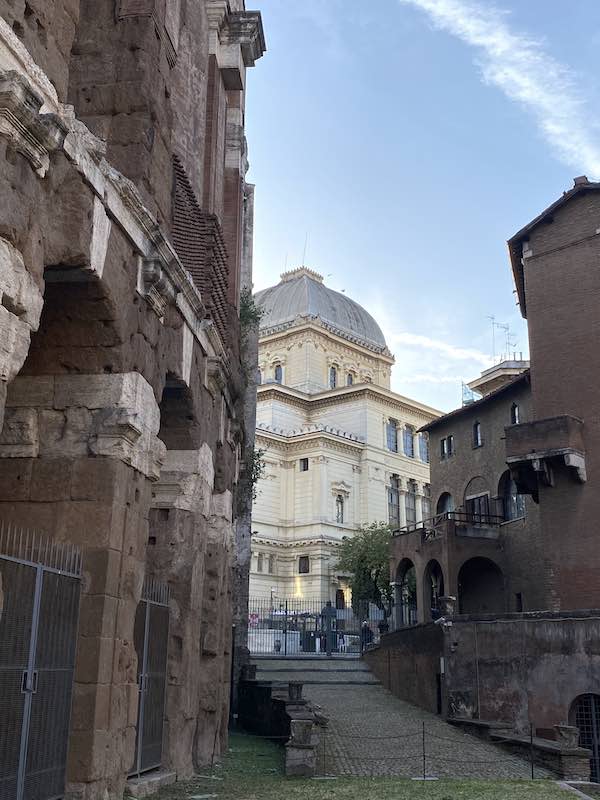
The museum is interesting to visit and has exhibits that teach about the life of the Jewish community in Rome from ancient times to now.
You can find info and virtual tour here
Address: Largo Stefano Gaj Taché (Sinagoga), 00186 Roma
Pietre d’Inciampo (Stolpersteine or Stumbling Stones)
Pietre d’inciampo are small brass plaques you notice isn several parts of Rome’s Ghetto (and not only), lodges into the ground.
At first sight, they look like brass cobbles; however, as you get closer, you will notice each them has a carving with a name dates. Each is, in fact, a way to commemorate one prerson who went thought the horror of the Jewish prosecution in Rome in nazi-fascist time.
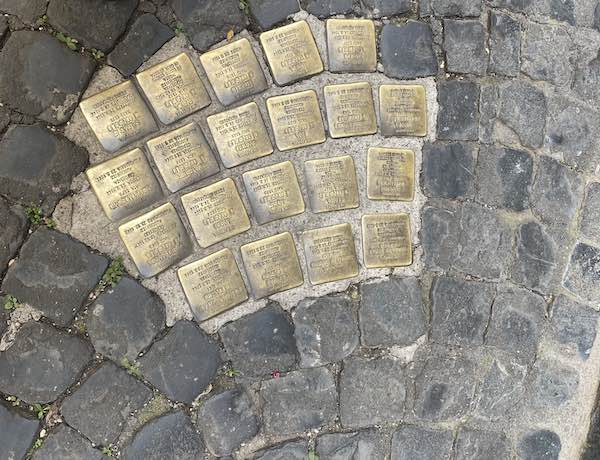
The Pietre d’Inciampo (lit. Tripping Stones) are recent: created by German artist Gunter Demnig in 1990, the plaques are called ‘stumbling stones’ or ‘tripping stones’ (inciampo = tripping, losing your balance) as this is exactly what they do.
They force you to stop your wandering and take a minute to learn and remember the events and the people they recall.
You find stumbling stones in several parts of the ghetto and other locations in Rome. In the city, there are over 200 of them.
Portico d’Ottavia (Octavia’s Portico)
Octavia’s Portico is an ancient Roman building still standing in the Jewish Gghetto of Rome, between the Theater of Marcellus and the Great Synagogue.
The portico is the only remaining part of the old Circus Flaminium and takes its name from Octavia, sister of Emperor Augustus, who rebuilt this portico in 23-27 AD.

The Portico is four-sided, it measures 119 x 132 meters and used to include several temples (Temple of Juno Regina and Temple of Jupiter Stator), two libraries and the Curia Octaviae, a large public meeting space.
In the Middle Ages, the area turned into a fish market (Foro Piscario) and acquired a church: the aptly named ‘Church of St Angelo in Pescheria’ (Pescheria = fish market).
Not all of this arrived to us however, this archaeological area is beautiful and charming: a well laid out pedestrian path allows to safely get close to the ruins from wither the Theater of Marcellus or Synagogue.
Fun fact! is of from here that, in 1347, Cola di Rienzo set out to conquer the Capitoline Hill!
Marcellu’s Theater
the Theater of Marcellus is on the edge of the Jewish Ghetto, just beside ancient Portico D’Ottavia.
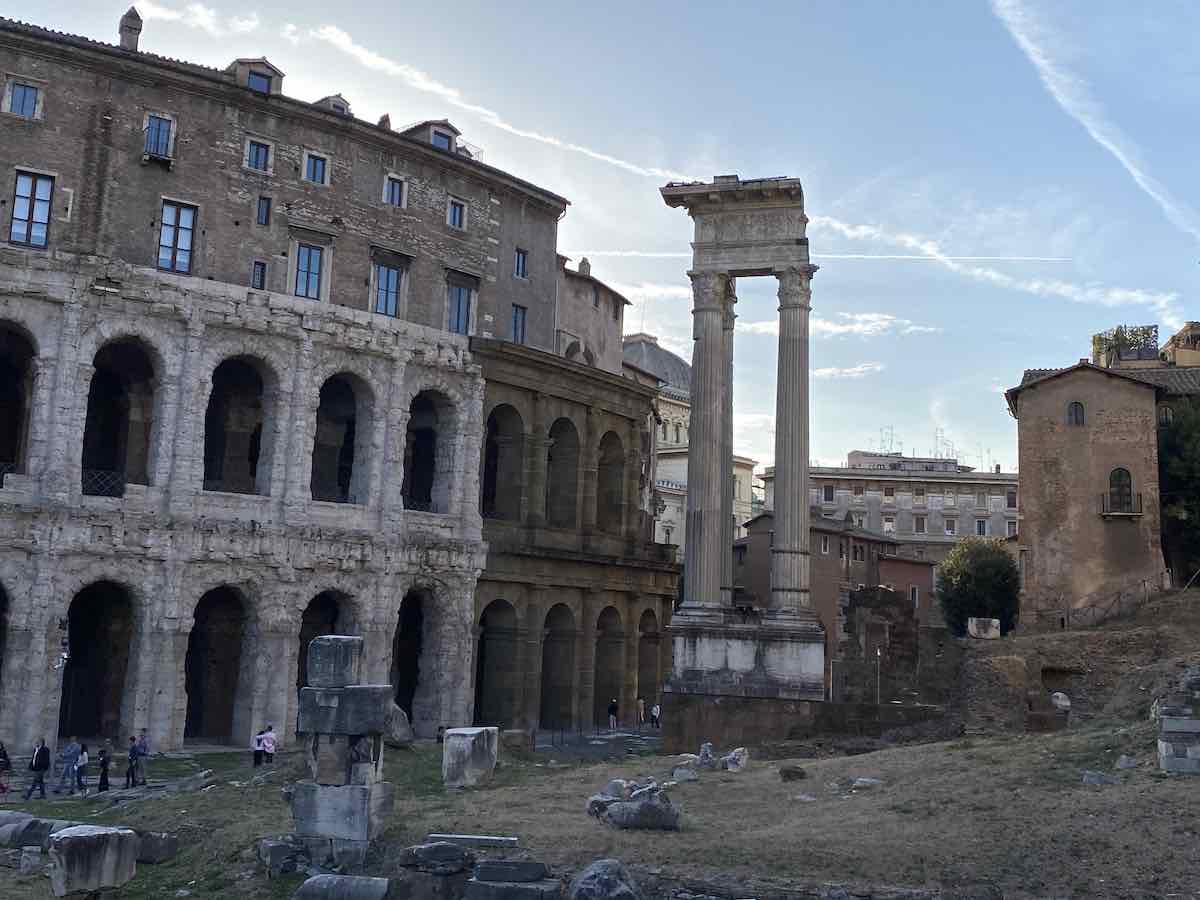
The Theater is a wonderful examples of ancient Roman theater and while close to the public, it easy to enjoy from the outside.
As you walk here, you will notice its imposing arches, reminiscent of those of the Colosseum, and you marvel at the presence of apartments (!) at the very top of this I century AD marvel!
You can read all about Marcellus’ theater here.
Piazza delle Cinque Scole and Rome’s Ghetto most charming streets
The Ghetto area is characterised by mostly small, pretty cobbles streets with buildings painted in the traditional Roman ochra and orange tones.
The best way to enjoy these roads is by allowing yourself to get lost: the area is rather small and you won’t stay lost for long, the Tiber and the Synagogue easily operating as your main bearings.
If you prefer directions, some of the prettiest streets in the area are Via della Reginella, via di Sant’Ambrogio, via del Tempio, piazza delle Cinque Scole and piazza dei Cenci.
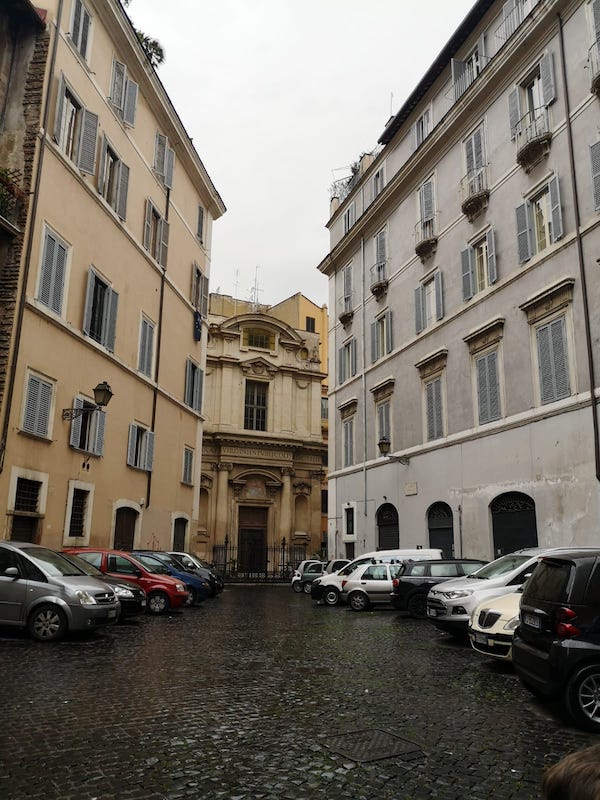
Worth of special attention is Piazza delle Cinque Scole, named after the five temples that existed in the area before the building of the Synagogue: one of the most fascinating squares in Rome
Tempietto del Carmelo
In Piazza Costaguti there is a peculiar building, know as Tempietto del Carmelo.
The Tempietto (lit. Little Temple) is a semi-circular strucrure with columns and dates from 1759, when a local family built it to protect a scacred image of the Virgin housed here.
After the war, the building was a in terrible state of repair and two shoemakers located here their place of business, securing the temple with a gate.
After they moved to more suitable spaces, the temples remained closed until 2005, when restoration work brought back the pretty columns and the inscription at the top of the temple, now well visible.

Piazza Mattei
Piazza Mattei is one of the prettiest squares in Rome and one of the most popular places for a drink and a rest Rome’s ghetto.
The square has a delightful fountain called Fountain of the Turtles and has several cafes with outdoor tables that make is a poplar hanging for locals and tourists alike.
This is one of the pretties fountains in Rome and one I highly recommend you seek out.

Piazza Margana
PIazza Morgana is at the edge of the Rome’s ghetto, towards Piazza Venezia.
This is a small square with medieval aspect and one of my favorite piazzas in Rome.
The piazza owes its name from the Morgana family who had there residence here in the 1400s and it is unique in Rome as it feels a little like a square in a small village: very different from large and busy Piazza Venezia and Torre Argentina nearby!

House of Lorenzo Manilio
Constructed in 1468, the house of Lorenzo Manilio is a peculiar building with a unique facade.
On its front, an inscription reads: URBE ROMA IN PRISTINAM FORMA ENASCENTE LAUR MANLIUS KARITATE ERGA PATRI EDIS SUO NOMINE MANLIANAS PRO FORT AR MEDIOCRITATE AD FOR IUDEOR SIBI POSTERISQ SUIS A FUND P AB URB CON MMCCXXI L AN M III D II P XI CAL AUG or ” While Rome is reborn to its ancient splendor, Lorenzo Manilio, as a sign of love for his city, built from the foundations on Piazza Giudea, in proportion to its modest possibilities, this house that takes the name of Manliana from its surname, for himself and his descendants, in the year 2221 from the foundation of Rome, at the age of 50, 3 months and 2 days; he founded the house on the eleventh day before of the calends of August “.
Lorenzo Manili also made sure his name was carved three times in Latin and one in Greek on the house, that the motto Ave Roma was on the windows, and he also embedded archaeological finds in the house plaster: all to show his love for the city!
What to eat in the Jewish Ghetto of Rome
The Jewish community of Rome is well known for delicious cuisine, traditional of this part of the city and regularly attracting people and foodies from all walks of life.
The specialities to try in this are are several and include:
- Jewish style artichokes (Carciofi alla Giudia) – a starter of fried artichokes.
- Stracotto (meat)
- Fish broth (brodo di pesce)
- Animelle con i ceci (lamb sweetbreads with chickpeas)
- Deep fried zucchini flowers
- Crostata ricotta e visciole (cottage cheese and sour cherries cake)
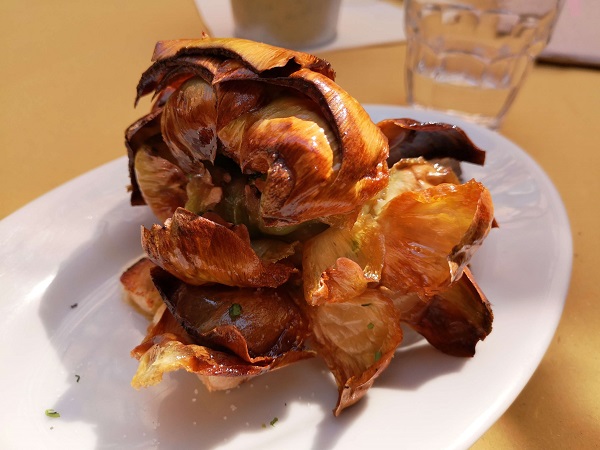
Best Jewish Ghetto Rome restaurants
There are many traditional and good restaurants in Rome’s ghetto. Some you may like to try are:
Pasticceria Boccione (Pastry shop): Via del Portico d’Ottavia, 1, 00186 Rome
Giggetto al Portico d’Ottavia: Via del Portico d’Ottavia, 21/a, 00186 Rom
Il Giardino Romano: lovely restaurant also visited by Anthony Bourdain. Via del Portico d’Ottavia, 18, 00186 Rom
Al Pompiere: Via di Santa Maria De’ Calderari 38, 00186 Rome Italy
What to see near the Jewish Ghetto of Rome
The Jewish Ghetto of Rome is in a central location, close to many attractions.
Near here you can visit:
Tiberina Island – the historical and charming island of the Tiber
Largo Argentina – a large Piazza with Archaeological area (it’s the location of Julius Caesar’s stabbing) and a cat sanctuary
Campo de’ Fiori – stunning piazza with plenty of history and, now, several outdoor cafes
Capitoline Hill and Piazza del Campidoglio – jewel of Renaissance architecture
Tours of the Jewish Ghetto of Rome
Several companies offer tours of this area, in most cases in the form of a food tour. Please enquire directly with the provided for dietary restrictions.
Tours you may enjoy are:
Rome Ghetto walking tour – two hour walking tour with local guide
Private guided Tour of Rome Ghetto and Trastevere District, by LivTours
Tour by the Rome Jewish Museum (enquire directly for info on their website) for a personalised, culturally rich experience
Rome Jewish Ghetto and Campo de’ Fiori Food Tour
Rome Jewish Ghetto Guided Walking Tour
Where to stay near the Jewish Ghetto of Rome
The area of the Jewish Ghetto is lovely for a stay.
Some addresses you may enjoy are:
Residenza Gens Giulia – in a fantastic position close to PIazza Mattei, this is a lovely accommodation option with pretty rooms with traditional Rome charme yet all the comforts (wifi, air conditioning, etc)
Otivm Hotel – 4 star ,lovely boutique hotel in a stellar position close to Rome’s Ghetto and the Capitoline Hill. It has delightful rooms and a wonderful rooftop terrace with views of the the dome of the Synagogue and the Capitoline Hill.
I hope you enjoyed this quick overview of the best things to see in the Jewish Ghetto of Rome and it helped you plan your visit. Safe travels to Rome!
Visitors’ Guide to the Jewish Ghetto of Rome – pin this!
